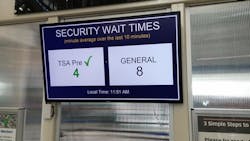CVG Fights Wait Times With Technology
As the media continues to show photos and video of growing Transportation Security Administration (TSA) checkpoint lines, one airport is using technology it says is helping.
Brian Cobb is the vice president, customer experience at Cincinnati/Northern Kentucky International Airport. “Security checkpoint line wait times were the single biggest complaint from our customer base, so we needed to do something to improve it,” he said. “First, we moved our lanes to a more central part of the building, because we weren’t using our space effectively.”
In 2011, the airport did a pilot program with Purdue University to see if the technology worked, said Cobb. “In 2013, we expanded the pilot with technology from Lockheed Martin, and that proved to be successful,” he said. “We implemented BlipTrack technology in June 2014.”
BlipTrack uses Wi-Fi sensor technology that tracks passengers via their smartphones. “Most people leave their Wi-Fi active, which allows our technology to sniff out that signal,” said Cobb.
BlipTrack can measure things like queue times, capacity and throughput. Sensors are installed at strategic points in in the checkpoint areas, making travel times, dwell times and movement patterns available. The technology can track regular and TSA PreCheck lines.
The airport collects data from Blip. “As a smartphone is sniffed, our system picks up a signal and assigns it an anonymous number tracked from multiple nodes around checkpoints. There has been no negative feedback from customers,” said Cobb. “Initially, there were questions on what we were doing with the information. But the end result was that if we were using it for good purposes, so be it. If you’re us helping to get through line faster, that’s not a bad thing.”
Once Cincinnati installed BlipTrack, lines went from 30 minutes to 15 minutes or less, said Cobb. “We have not been immune to the headcount changes at TSA,” he said. “But because we have this technology, we can put our queue information in the hands of TSA so they can adjust our lines accordingly.”
The key for the airport was approaching TSA in a cooperative way, said Cobb. “As part of the airport authority, we told TSA that we were looking at this technology to get away from manual counting and instead, going for real-time information on our lines,” he said. “We also periodically reach out to TSA in Washington, D.C., to make sure we aren’t doing things outside of the norm. We don’t touch TSA equipment, so we didn’t need any permissions, but we wanted to be transparent. And it’s paid off in droves.
“We can say ‘here’s what’s happening with lines day to day to the minute,” said Cobb. “It helps everyone, right down to the person standing in line. We literally put wait times in their hands.”
As passengers enter the checkpoint, they also see wait times, said Cobb. “If you take out the fear of the unknown, you can reduce the anxiety of checkpoint lines,” he noted. “We’re also collecting the data for predictive analytics. A year from now, I’ll be able to better anticipate what wait times will be.”
The airport’s challenge trying to understand what type of customer is traveling, said Cobb. “Right now, I can’t tell if someone is a Delta Air Lines business traveler or an Allegiant Air leisure traveler, and that has an impact on security wait times,” he said. “It can be a challenge to manage the lines better, so that information is the holy grail. If we can get those profiles, that would allow us to predict when they show up at the checkpoint and adjust accordingly.”
Cincinnati has been open about sharing its experience with Blip technology with other airports, said Cobb. “We’ve be a big proponent of this technology, but it’s definitely not one size fits all,” he said. “But this technology fits our facility constraints and helps us get the best data.”
And adding more staffing may not be the answer, said Cobb. “Why not use this technology to help better staff checkpoint lines with existing staff? One challenge we have is large peaks and valleys,” he said. “We can have 30 flight departures in the early morning. But after 9:00, it’s next to nothing, then there’s another surge around 11. It can be challenging to staff that.”
Cobb strongly recommends working with the TSA on projects like this. “You’ll have more success partnering with them that if they do it blindly. It’s not helpful for either side not to work together,” he said. “And TSA in D.C. is looking at this technology, how it works and what the passenger experience is. So take the opportunity to partner rather than finger point.”
About the Author

